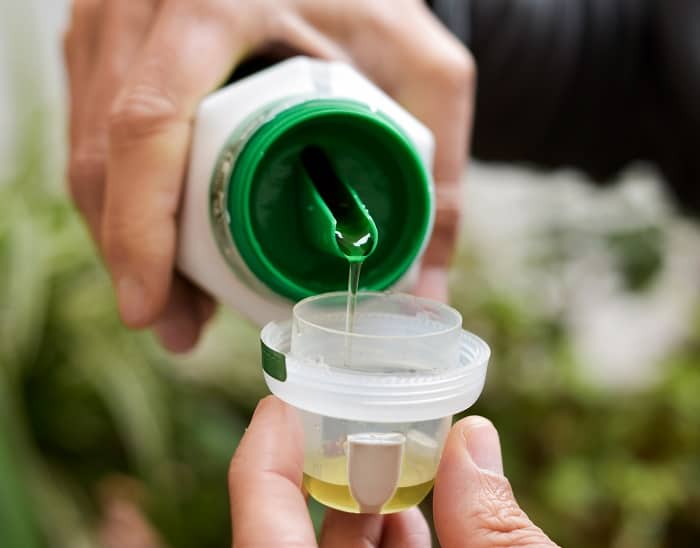Last Updated on March 2, 2023
Using the right kinds of feed and fertilizer for your plants is important, but is miracle growth toxic? Can it be used safely within your garden? Let’s take a closer look.
Grasses, plants, trees, flowers, birds, and butterflies. Who doesn’t love gardens? The scent of the lovely flowers, the birds chirping and the butterflies flying around, are all good to look at. But, a fruitful plant cannot be as productive as it could be, if not cared for correctly. Every gardener has their own strategy for growing their plants. One is by using the right kind of plant food.
What is a Plant Food?
Plant food is any substance like animal dung or a combination of nitrates used to make the soil more productive.
What is a Fertilizer?
A fertilizer is a chemical or natural substance added to soil to make it more fertile.
Is Plant Food a Fertilizer?
Plant food and fertilizer are often used interchangeably. Fertilizer indeed helps plants get the needed nutrients to grow and blossom properly. In terms of how they are used, plant food and fertilizer are not the same.
What is Miracle-Gro?
This is a type of plant food by Scott’s Miracle-Gro Company that every gardener knows. It provides readily available materials needed in the production of new cell structures within plants. It quickly feeds through the leaves and roots.
What is it used for?
It is used for flowers, vegetables, trees, and shrubs.
How do you use it?
Miracle-Gro can be used in two different ways:
- Through a feeder- 1 feeder refill packet can cover up to 500 sq. ft.
- Through a watering can- 1 tablespoon mixed with a gallon of water
There is also a suggested quantity that should be used:
- For roses with small bushes, 1/2 gallon should be used while a gallon should be used for big bushes. Feeding should be done every 7-14 days.
- For all flowers and vegetables, 1 gallon should be utilized for every 10 square feet, every 7-14 days.
- For indoor plants, however, only half a teaspoon should be mixed with a gallon of water. Also, leaf feeding for houseplants is not recommended. This mixture should be applied every 2 weeks.
Is Miracle Grow Toxic to Humans?
There are still no studies conducted to rule out its toxicity to humans. However, some of the ingredients of Miracle-Gro have serious effects on the surroundings and humans, too. As with any product, caution is always a great mindset to adopt.
What are the effects of some of the ingredients of Miracle-Gro on the environment?
The accumulation of nitrates in the soil causes water pollution if exposed to a flowing water source. Excessive use of artificial fertilizers can damage the natural composition of soil eventually.
Plants that grow in such soil will not have enough of their ingredients like iron, carotene, zinc, copper, protein, and vitamin C. It can also burn the roots of the plants when excessively given.
What are the effects of some of the ingredients on the garden itself?
It may harm the plant that it is supposed to strengthen if used improperly. One of the ingredients of the fertilizer is nitrogen which, if given in large quantities, can prevent shrubs and trees from blooming the way they used to.
It also contains a high volume of salt which, as time passes by, ransacks the soil of its natural nutrients and prevents plants from absorbing them. Gardeners tend to overfeed their plants, thinking that this will aid in the fast growth of their plants.
Those who apply it too much compromise not only the depletion of their current harvests but also indefinitely damage their spaces.
What are the effects of some of the ingredients on humans?
Excess nitrate levels in the soil create plants that, when eaten, turn to toxic nitrites in the intestines. Miracle-Gro should not be eaten, but if ingested accidentally can irritate the mouth, throat, esophagus, and stomach as it contains urea, an irritating ingredient present in plant food.
When irritation occurs, the person will experience nausea and vomiting. In addition, some of its ingredients can harm the soil itself, thus, can contaminate groundwater. Groundwater, as the primary source of potable water in the rural areas of the United States of America, can be greatly affected.
Various adverse health effects on humans can include:
- methemoglobinemia- also known as the blue baby syndrome
- various cancers
- Poor reproductive outcomes- like neural tube defects
- diabetes
- thyroid conditions
Miracle-Gro Came in Contact With My Eyes, What Should I Do?
Immediately flush your eyes with plenty of water and continue flushing for 15 minutes. If irritation further develops, seek medical treatment.
What is Miracle Grow Made of?
If you’re wondering what ingredients are in Miracle-Gro, then look no further. Typically it contains the following derivatives:
- ammonium sulfate
- potassium phosphate
- potassium chloride
- urea
- urea phosphate
- boric acid
- copper sulfate
- iron EDTA
- manganese EDTA
- sodium molybdate
- zinc sulfate
Does Miracle-Gro Have Nitrogen?
Yes, it does. Its high levels of nitrogen are one of the reasons it should not be used in excess for your plants. If used too much, it can cause harm to both your soil and your plants. Miracle-Gro not only contains high levels of nitrogen but also phosphorus and potassium too. This particular type of fertilizer is 15:30:15. This means that it contains 15% nitrogen, 30% phosphorus, and 15% potassium.
Why is Miracle-Gro Blue?
There are two main reasons why Miracle-Gro is blue. The first is because of the use of copper sulfate, which is blue. However, another reason is that synthetic fertilizers are sometimes dyed. This is because it makes it abundantly clear that it should not be consumed and is only to be used for fertilizing. When a fertilizer is darker in color, it usually means it contains more nutrients.
Is Miracle Grow Toxic?
When it comes to Miracle-Gro it is seen as both nontoxic and not hazardous for both humans and dogs. However, this does not mean it’s not harmful to both human and dog health if ingested or if contact is made with your skin. For example, it can irritate if it comes into direct contact with your eyes or skin, and you should contact a vet or doctor for advice, if possible.
If Miracle-Gro is ingested, it can cause gut issues such as sickness and diarrhea. If this happens to you or your dog, you should keep hydrated and seek medical advice from either a vet or a doctor.
Miracle-Gro vs Organic Fertilizer
Miracle-Gro is a type of synthetic fertilizer and there are many differences between organic fertilizers and synthetic fertilizers. Simply put, organic fertilizers are made from natural resources, whereas synthetic fertilizers are man-made in a lab. Let’s take a look at some of the differences between the two.
Synthetic fertilizers feed the plant, whereas organic fertilizers feed the soil and give both the plant and soil nutrition. As well as this, synthetic fertilizers are easy to find and usually cheaper than organic fertilizers. Also, while organic fertilizers are great for the entire ecosystem, synthetic fertilizers usually do little for the surrounding environment or soil; just the plant itself.
It’s also worth mentioning that if used too much, synthetic fertilizers can burn your plants whereas this is unlikely to happen with organic fertilizers. And finally, if you’re looking for exact measurements on nutrients, synthetic fertilizers are precise; whereas organic can vary.
Organic Fertilizers to Use Instead
You may decide that you’d prefer to use organic fertilizers for your garden. If so, you can try one of the following options:
- alfalfa meal
- making your own compost
- leaf mulch
Safety Precautions in Using This Plant Food
Here are some more important reminders when using the Miracle-Gro product:
- According to its Manufacturer’s Safety Data Sheet, when it is accidentally ingested, immediately rinse your mouth with water. Seek medical attention immediately. Call a doctor or poison control center and do not induce vomiting unless instructed to do so.
- If a person accidentally inhales its powder, take them outside or to a well-ventilated area and monitor for subsequent irritation. If coughing or additional problems persist, call out for medical assistance.
- If irritation on the skin happens, remove the contaminated clothing. Wash the affected area thoroughly with soap and water. If irritation occurs and becomes persistent, ask for help for medical intervention.
- Always wash your hands after handling the product. Avoid inhaling the specks of dust present in the product. Put it in a tightly sealed container and keep it closed when it is not in use.
- Using the original packaging of the product is still the best way to store the remaining plant food. By doing this, you can ensure that this will not be mistakenly identified as other products, which, in turn, may present a risk to one’s health.
- Apply the product properly. Read the instructions very well, even if you already know how to do it. The packaging will show you how, when, and where to apply the product properly.
- Keep this out of reach of children. Store the product away from your home. It is better to store it in your garden storeroom or maybe in the garage. In this way, you will prevent further accidents from happening inside your household.
- Keep it away from direct sunlight. Extreme temperatures may damage the composition of the product, thus, altering its effectivity in the growth of your plants.
Conclusion
I hope this post has helped to answer the question: is miracle grow toxic? The truth is, it’s marked as nontoxic. However, it can cause many issues if it is ingested, so it’s important to be extremely cautious with this product when using it; particularly if you have pets. Do you have any tips or tricks when it comes to using Miracle-Gro? If so, please feel free to let me know in the comments below. And remember, sharing is caring!
FAQs
What's a good resource on how to use it?
The Miracle-Gro website provides a lot of information on the product, including how to use it and why it's so effective. There are also links to other Miracle-Gro products that might be better for your plants. The site also has many helpful tips on how to get the most from your Miracle-Gro products. You can learn about how to get the best results with your plants by reading the Miracle-Gro Tips page.
How toxic is Miracle Grow?
Miracle Grow is probably one of the most popular and well-known plants sold at your local garden center. It is also one of the most controversial and toxic weeds to be found in gardens.
Miracle Grow is a very effective herbicide and can be used as a foliar feeder. Many people believe that Miracle Grow is the only way to control this pesky weed. While Miracle Grow does work, it is not the best choice for every situation. In some cases, you will need to use other methods such as hand pulling, mechanical removal, or even using a herbicide.
The problem with Miracle Grow is that it can cause damage to your lawn and even harm your grass. You may also be at risk of having your lawn become infested with Miracle Grow.
Miracle Grow is the third most toxic pesticide on the market. The top two are Roundup and 2,4-D, both of which have been linked to cancer and other health problems.
EWG’s report found that Miracle Grow contains an ingredient called metolachlor which is classified as a probable human carcinogen. According to the EWG, metolachlor is one of the most heavily used pesticides in the country.
Why you shouldn't use Miracle-Gro?
Miracle-Gro and other chemical lawn care products are not bad for your lawn, but they can be harmful to the environment and your health.
If you don’t have to, don’t. When it comes to plants, there are many ways to make sure your garden is thriving. The best approach is to start with the basics: healthy soil, well-placed and properly sized plants, and a water supply that keeps your garden well-watered.
Generally speaking, you should stop using Miracle-Gro and go organic.

Josephine is an enthusiastic gardener who loves to spend her spare time tending to her garden. She is passionate about growing her own food, and aspires to one day have her own vegetable garden. Josephine is also an animal lover and often takes in stray cats and dogs. She enjoys spending time with her pets in the garden, and is often seen playing with them or watering her plants. Josephine is an avid reader and enjoys learning about new gardening techniques and plants. She is always looking for ways to improve her garden and make it more beautiful. She is a great friend, always willing to lend a helping hand when needed. Josephine‘s passion for gardening and love of animals make her a wonderful addition to any garden.


